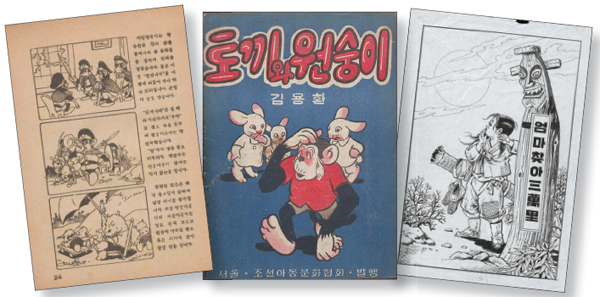3 cartoons deemed registered cultural property

Cartoons “Gobau Yeonggam (Old Man),” “Rabbit and Monkey” and “30,000 Ri to Finding Mom” have been designated as cultural properties of Korea. Provided by the Korea Manhwa Contents Agency
This marks the first time that cartoons have become Korea’s state-designated cultural property.
The announcement was made by Korea Manhwa Contents Agency on Feb. 8, quoting a decision made by the Cultural Heritage Administration. Manhwa, in Korean, means cartoon. The Korea Manhwa Contents Agency is keeping and managing “Rabbit and Monkey” and the “30,000 Ri to Finding Mom.”
“The registration shows that cartoons also have value as cultural properties,” said Oh Jae-rok, a director of the agency. “We will work to register more historic cartoons on the cultural property list.”
“Rabbit and Monkey” was made on May 1, 1946 - a year after Korea’s liberation from 35-year Japanese colonization. It was drawn by the respected cartoonist Kim Yong-hwan (1912-1998) and based on the children’s story made by writer Ma Hae-song (1905-1966).
The cartoon uses animals and the literary tool of personification as well as metaphor and symbolism to criticize Japan’s unjust colonization of Korea and expresses the wish for Korea’s independence and sovereignty.
It is thought to be Korea’s oldest surviving cartoon book. The Korea Manhwa Contents Agency purchased it in an auction in May of last year.
While “Rabbit and Monkey” portrays life under Japanese colonization, “30,000 Ri to Finding Mom” depicts the life in Korea after the Korean War (1950-1953). A Korean ri is approximately 393 meters (1,289 feet), and “30,000 Ri” is a long, long journey.
“30,000 Ri to Finding Mom,” made by Kim Jong-rae (1927-2001) and first published in 1958, is set in the Joseon Dynasty (1392-1910) and is about Keum-jun, a boy who embarks on a journey to find his mother, who was sold elsewhere as a slave.
Although it is set in the Joseon era, the story is intended to portray the destitute life in post-war Korea. The fine writing made the book so popular it went through 10 printings between 1958 and 1964 due to steady popularity.
“Gobau Yeonggam” also made history in the Korean cartoon arena: It ran in Korean newspapers from 1950 until 2000, a total of 14,139 cartoons. It is the longest-running editorial cartoon, particularly known for criticizing the dictatorship and military governments of Korea.
Part of the cartoon is owned by cartoonist Kim Seong-hwan, while part of it is owned by the Dong-A Ilbo.
“A newspaper without an editorial cartoon is tantamount to giving up an important weapon,” Kim told the Dong-A.
“Even if Korea is now a democratic society, there are oppressions that are taken for granted. Editorial cartoons that can give a fresh take on such oppression are still very important and necessary.”
By Kim Hyung-eun [hkim@joongang.co.kr]










with the Korea JoongAng Daily
To write comments, please log in to one of the accounts.
Standards Board Policy (0/250자)